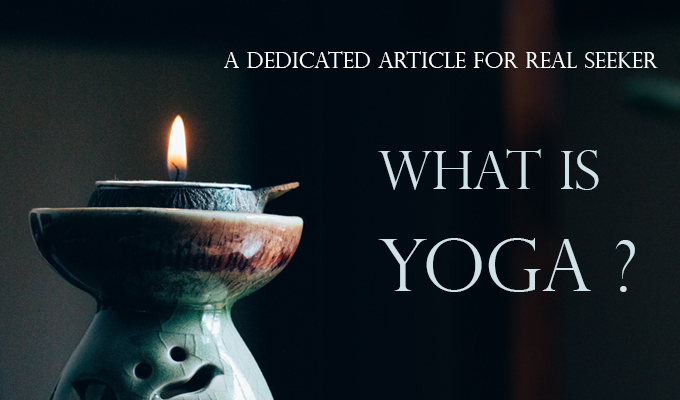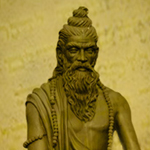
When you first hear the word yoga, you might picture physical postures or breathing exercises. Many people think yoga is just a way to improve flexibility, build strength, or relax the mind.
But yoga is much more than that. It is a path that connects the body, mind, and soul. It helps you discover your true self and live with greater awareness.
In this article, we explore the traditional Indian meaning of yoga, its ancient roots, and how it has spread across the world. From its origin to its deeper purpose, here is everything you need to know about what yoga truly is.
Definition of yoga
Yoga is a way of life that helps a person reach their highest potential. It is the path that leads to inner awareness and unity with the entire creation.
The word yoga comes from the Sanskrit root ‘Yuj’, which means to join or to unite. Yoga is the practice of creating connection at every level of being.
Through yoga, we connect:
- The soul with the supreme soul
- The ego-self with the higher Self
- Individual consciousness with universal consciousness
- The body and mind with the soul
This union is the true purpose of yoga. It goes beyond physical exercise and becomes a journey of self-realisation.

3 Aspects of Yoga
Yoga is traditionally practised through three core aspects discipline, devotion, and knowledge. Together, these guide the yogi towards Samadhi, the state of complete spiritual absorption.
Although different religions have shaped their own goals for yoga, the basic structure and sequence of practice remain consistent across traditions.
Yoga originated in India and has always included a combination of practices that support physical, mental, and spiritual growth. These include:
- Living by moral and ethical values
- Studying spiritual philosophy
- Practising physical postures (asanas) to keep the body strong and flexible
- Using breathing techniques (pranayama) to control the life force (prana)
- Chanting mantras to focus the mind and uplift energy
- Meditating to quiet the mind and connect with the inner self
Ancient Hindu sages and ascetics followed this path with deep commitment. Through regular and disciplined practice, they experienced a union of body and mind with the supreme soul, also known as pure consciousness. In this deep meditative state, the intellect (buddhi) becomes still and silent.
This state is called Ananda, meaning inner bliss. It is the experience of peace beyond the distractions of the material world, where one feels complete oneness with the universe.
In the modern world, yoga is often viewed as a physical workout or a relaxation method. However, at its core, yoga is a spiritual science that leads to self-realisation.
From the very beginning, the true aim of yoga has been to guide each person towards their real naturebeyond body and mind.
Even modern science supports this idea, suggesting that the entire universe is formed from a single source of subtle energy. A person who becomes one with this energy is said to be in the state of yoga.
The science of yoga: how does it work?

The science of yoga is deeply rooted in ancient wisdom and was systematised by sage Patanjali, a great Indian philosopher and psychologist from the 2nd century BCE. He compiled the foundational text of classical yoga, known as the Yoga Sutra, and is often called the father of classical yoga.
Patanjali’s Yoga Sutra focuses on mastering the mind, growing spiritually, and learning to perceive beyond the five physical senses.
He understood that most people depend on the outside world for fulfilment. This constant search for external success creates patterns of thought in the mind, leading to restlessness and distraction. As a result, our awareness turns outward, and we forget to ask deeper questions like:
- Who am I?
- Why am I here?
- What is the truth of my existence?
Yoga helps us return to these questions by calming the mind and balancing the body.
How does yoga calm the mind?
When we practise a yoga pose, a breathing technique, or meditation, we direct our attention to a specific action or feeling. This focused awareness allows the mind and body to work together.
As this connection grows stronger, we stop relying only on the limited information provided by our senses. The body and mind begin to stabilise.
When this inner stability is achieved, our awareness turns inward, and the constant stream of thoughts slows down. This is how yoga helps reduce mental noise and brings clarity and stillness.
Through consistent practice, yoga allows us to move beyond mental distractions and experience the deeper self within.
Foundation of yoga: yogic philosophy
The philosophy of yoga is one of the six major schools of Indian philosophy, known as the Shad Darshanas. These are:
Samkhya, Yoga, Nyaya, Vaisheshika, Mimamsa, and Vedanta.
Among these, Yoga philosophy is the most practical. It combines spiritual knowledge with step-by-step methods for personal transformation. While Samkhya is a non-theistic path to liberation (moksha), Yoga includes the idea of surrendering to a higher power, called Ishvara (God), as part of the path to liberation.
Core Concepts of Yogic Philosophy
Yoga philosophy is based on five main concepts:
- Purusha and Prakriti – the two fundamental elements of existence
- Trigunas – the three qualities of nature that influence the mind and behaviour
- Yamas and Niyamas – ethical principles for a disciplined life
- Ashtanga Yoga – the eight-limbed path described by Patanjali
- Paths of Yoga – four spiritual paths to self-realisation
1. Purusha & Prakriti
According to yoga philosophy, our existence has two layers:
- Prakriti (nature or matter) – allows us to experience the physical world
- Purusha (pure consciousness or soul) – is the true self, the silent observer
Purusha is eternal, changeless, and free from pain or desire. It is the source of all experience but remains unaffected by it.
Prakriti, on the other hand, is the ever-changing material world. It includes the body, mind, senses, and emotions. It is through Prakriti that we live and act, but it is also what creates illusions (Maya) that keep us attached to worldly things.
Yoga teaches that the soul (Purusha) sees the world through filters or impressions created by the mind. These mental patterns are known as Vrittis, as described in Patanjali’s Yoga Sutra:
“Yoga Chitta Vritti Nirodha” – Yoga is the stilling of the fluctuations of the mind.
When we stop identifying with the mind and its patterns, we reconnect with our true self. The practice of yoga helps dissolve these Vrittis and frees us from the illusion created by Prakriti.
2. Tri-Gunas
Trigunas are the three qualities that make up human nature and influence the way we think, feel, and act:
Sattva, Rajas & Tamas are the three qualities of a living being.
- Sattva – purity, clarity, wisdom, peace
- Rajas – energy, passion, movement, desire
- Tamas – darkness, laziness, ignorance, confusion
Every individual carries a mix of these three qualities, but one is usually dominant at a time. The goal of yoga is to increase Sattva, which leads to clarity of mind, balance, and spiritual growth.
By reducing Rajas and Tamas through ethical living, mindful actions, and meditation, we move towards a more peaceful and aware state of being.
History of yoga: origin & development timeline
The history of yoga goes back thousands of years. It developed through various stages, each contributing to how we understand and practise yoga today. Here is a timeline of the major periods in the history of yoga:

1. Pre-vedic period (3300–1300 BCE)
Signs of early yoga practices were found in the Indus–Saraswati Valley Civilisation in Northern India. Seals from this time show figures in meditative postures, suggesting the roots of yoga were already forming.
2. Vedic period (1700–500 BCE)
The Vedas are the oldest sacred texts of Hinduism, containing hymns, mantras, and rituals. The word “Yoga” was first mentioned in the Rigveda.
The Atharvaveda describes a group of ascetics called Vratyas who practised physical postures that later evolved into modern yoga poses.
During this time, Rishis or Vedic yogis shared spiritual teachings and guided people in rituals, meditation, and Tapas (austerity). This is known as Vedic Yoga, aimed at uniting with the divine through self-sacrifice and deep meditation..
3. Pre-classical period (500–200 BCE)
In this period, yoga ideas began appearing in spiritual texts like the Upanishads and the Bhagavad Gita.
The Katha Upanishad described yoga as a bridge between the mind and the soul, achieved through posture, breath control, and focused meditation.
The Bhagavad Gita introduced three main paths of yoga:
- Karma Yoga – the yoga of action
- Bhakti Yoga – the yoga of devotion
- Jnana Yoga – the yoga of knowledge
In Buddhism, early texts like the Pali Canon also described meditation and mindfulness practices similar to yogic teachings.).
4. Classical period (200 BCE – 500 CE)
This period saw the development of a clear and organised system of yoga, mainly through the work of sage Patanjali.
Patanjali compiled the Yoga Sutras, a collection of 196 aphorisms that laid the foundation of Classical Yoga or Raja Yoga the yoga of controlling the mind.
The Ashtanga Yoga system (Eight Limbs of Yoga) described in these sutras includes ethical rules, postures, breath control, and meditation, all aimed at reaching Samadhi (spiritual liberation).
5. Post-classical Period
This period shifted the focus of yoga from liberation alone to improving life in the present moment.
Texts like the Bhagavata Purana introduced Viraha Yoga practices of separation from the material world to connect with Krishna through devotion and meditation.
Later, yoga masters explored the body’s hidden energy systems. This led to the rise of Tantra Yoga, which combines breath, movement, sound, and rituals to awaken higher consciousness.
6. Modern period (18th century – present)
The modern era brought yoga to the global stage.
Swami Vivekananda was one of the first Indian yogis to spread yoga in the West. His speech at the Parliament of the World’s Religions in Chicago in 1893 introduced the spiritual depth of yoga to a global audience.
Other key figures include:
- Paramahansa Yogananda, who introduced Kriya Yoga and founded the Self-Realization Fellowship
- Swami Sivananda, who established the Divine Life Society in Rishikesh and authored over 200 books on yoga philosophy and practice
In the 20th century, Hatha Yoga became popular in the West through the efforts of modern yoga masters like:
- T. Krishnamacharya – considered the father of modern yoga, opened a yoga school in Mysore in 1931
- B.K.S. Iyengar – founder of Iyengar Yoga, known for precise alignment and the use of props
- Pattabhi Jois – developer of Ashtanga Vinyasa Yoga
- T.K.V. Desikachar – founder of Krishnamacharya Yoga Mandiram (KYM), a centre for yoga therapy in Chennai
These teachers helped transform yoga into a worldwide practice, combining traditional wisdom with modern needs.
The yogic tree: 6 main branches of yoga
Yoga is not limited to physical exercises. It is a complete science of life that helps balance body, mind, and soul. Ancient yogis developed six main branches of yoga to guide people with different interests and temperaments toward one common goal Self-realisation.
Each branch has its own path and method, but all aim to bring inner peace and union with the higher self. You can practise one or a combination of branches based on your nature and life goals.
1. Hatha Yoga
Hatha Yoga is the most well-known branch today and forms the base of modern yoga. The word “Hatha” comes from “Ha” (sun) and “Tha” (moon), symbolising the balance of energies within the body.
It focuses on:
- Physical postures (asanas)
- Breathing techniques (pranayama)
- Purification and inner balance
Hatha Yoga prepares the body for deeper spiritual practices by making it strong, stable, and calm.
2. Tantra Yoga
Tantra Yoga is a spiritual science that uses rituals, breath, sound, and movement to awaken subtle energies in the body. It aims to overcome the limitations of body and mind caused by repetitive patterns and attachments.
Key practices include:
- Energy channeling (nadis and chakras)
- Mantra chanting
- Kundalini awakening
- Meditative rituals
Tantra is often misunderstood but at its core, it helps expand consciousness and spiritual awareness.
3. Karma Yoga
Karma yoga is the pathway to selfless action. According to karma philosophy, every action is served as an offering to the divine (God) without any outcome desired. Karma yoga is something you can practice out of mat anytime, anywhere.
To learn more about what benefits karma yoga gives when practiced regularly, you should definitely read this guide of karma yoga.
4. Bhakti Yoga
Bhakti Yoga is the path of love, devotion, and surrender to a higher power or deity. It involves heartfelt prayer, chanting, and seeing the divine in all beings.
Practices include:
- Singing devotional songs (bhajans or kirtans)
- Prayer and worship
- Offering every thought and action to God
Bhakti Yoga softens the heart, removes ego, and leads to deep emotional connection with the divine.
5. Jnana yoga
Jnana Yoga is the yoga of inner wisdom. It helps you discover the truth by asking questions like “Who am I?” and “What is real?”
Main tools of Jnana Yoga:
- Self-inquiry (atma vichara)
- Study of spiritual texts (like Upanishads and Bhagavad Gita)
- Reflection and meditation
It is best suited for seekers with a sharp intellect and a deep interest in spiritual knowledge.
6. Raja Yoga
Raja Yoga, also known as the “Royal Path“, focuses on gaining control over the mind. It is based on the Yoga Sutras of Patanjali, which describe the eight-limbed path (Ashtanga Yoga).
These steps include:
- Moral discipline (Yamas and Niyamas)
- Physical postures (Asanas)
- Breath control (Pranayama)
- Concentration (Dharana)
- Meditation (Dhyana)
- Ultimate absorption (Samadhi)
Raja Yoga is a complete path for mastering thoughts, emotions, and consciousness.
Yoga Benefits
People often look for a reason before starting something new. In the case of yoga, there are not just one or two, but dozens of proven benefits for your body, mind, and soul.
Yoga works on every level of your being—from tiny cells to major organs. It supports physical health, mental clarity, emotional balance, and spiritual growth.
Here are some key benefits of practising yoga regularly:
- Improves flexibility and strength
- Supports healthy posture and spine alignment
- Enhances focus, memory, and mental calmness
- Reduces stress, anxiety, and depression
- Improves digestion, metabolism, and immunity
- Promotes better sleep and energy levels
- Balances hormones and boosts circulation
- Increases self-awareness and mindfulness
- Helps in emotional healing and self-acceptance
- Connects you with inner peace and clarity
Whether you want to improve your health, reduce stress, or explore your spiritual path, yoga offers a complete system to support your journey.
👉 Explore 46 Science-Backed Benefits of Yoga
Conclusion
Yoga is not just exercise it is a way of life. Rooted in ancient Indian wisdom, it continues to guide people across the world towards health, harmony, and self-awareness.
Whether you seek better physical health, a calm mind, or spiritual growth, yoga offers a complete path to transform your life.





Dear Sir,
I m writing this with great belief in Hast Mudra.
My wife (44 Yrs Old) treated and survived with great difficulties from the “Viral Encephalitis”. It’s a brain-related disease. The advanced stage of Manigities.
Can you suggest which Yoga or Hast Mudra she should start for recovery? Pls reply
Regards
Vayu mudra is considered good for brain-related problems. Please refer this article for in-depth instructions on mudra.
However, I would suggest you in-person consultation with a yoga therapist before relying completely on a yoga exercise.
In my younger days when I was suffering from Diabetes then I started to practice “Uddiyana Bandha “, for a year with dietary restrictions and got rid of Diabetes. Now I am 78 and no any restrictions. And again I started to practice “Uddiyana Bandh ” and “Pashtimotanasan “and Ardhmatsyensan.
Very good information which is most important to the society which is undergoing
a diffrent situation. Every one should know it other wise there is no solution for their
self distraction of life.
What a Wonderful site
Absolutely stunning and great domain
Would like to know more about Saptarishi and how they spread yoga teaching around different parts of the Earth.
I am very happy to read your article because it has given me a lot of information.
very nice briefly explained the entire yoga philosophy
Thank you for sharing knowledge.
The way Yoga helps relaxing the body and mind, I don’t think one would be able to get the kind of benefits with any other things. Nothing comes closer to the Yoga and people have lot to share about. This traditional way to relax is getting popular in western countries too and credit goes to the entire GURUS across the world.
Keep sharing the amazing stories.!!!
I like the idea that I’ll be able to still the patterns of my thought process through yoga. In addition to that, I think that I should also pursue becoming a teacher of yoga so that I can impart good knowledge to many people. I’ve always been fascinated by different cultures and connecting with people, so maybe undergoing training will help me achieve this.
Just started reading from fitsri..thanku for sharing such valuable information in a easy way.. It’s really amazing, you really did a wonderful job.. Pls continue the same
So far, by reading this post i am able to make my own understanding of yoga’s basics. Nicely explained the concept of thought patterns of mind & how practice of yoga is designed to eliminate it.
Well, now i can feel, Yoga is more beautiful practice when you understand its aspects beyond the physicality.
Thanks for your valuable feedback Somashi Ravishankar. You understand it right, higher realization in yoga begins when you start knowing it beyond the physical aspects only.